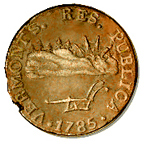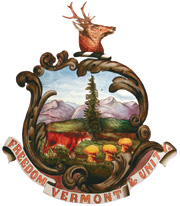
A coat of arms is a heraldic visual design on an escutcheon, surcoat, or tabard. The coat of arms on an escutcheon forms the central element of the full heraldic achievement, which in its whole consists of a shield, supporters, a crest, and a motto. A coat of arms is traditionally unique to the armiger. The term itself of 'coat of arms' describing in modern times just the heraldic design, originates from the description of the entire medieval chainmail 'surcoat' garment used in combat or preparation for the latter.

A motto is a sentence or phrase expressing a belief or purpose, or the general motivation or intention of an individual, family, social group, or organisation. Mottos are usually found predominantly in written form, and may stem from long traditions of social foundations, or from significant events, such as a civil war or a revolution. A motto may be in any language, but Latin has been widely used, especially in the Western world.

The coat of arms of Bulgaria consists of a crowned golden lion rampant over a dark red shield; above the shield is the Bulgarian historical crown. The shield is supported by two crowned golden lions rampant; below the shield there is compartment in the shape of oak twigs and white bands with the national motto "Unity makes strength" inscribed on them.

The flag of the state of Vermont displays the coat of arms and motto of the U.S. state of Vermont on a rectangular blue background. The Vermont General Assembly adopted this flag on June 1, 1923.

The current coat of arms of Zimbabwe was adopted on 21 September 1981, one year and five months after the national flag was adopted. Previously the coat of arms of Zimbabwe was identical to the former coat of arms of Rhodesia.

The Great Seal of the State of Colorado is an adaptation of the territorial seal which was adopted by the First Territorial Assembly on November 6, 1861. The only changes made to the territorial seal design being the substitution of the words, "State of Colorado" and the figures "1876" for the corresponding inscriptions on the territorial seal. The first General Assembly of the State of Colorado approved the adoption of the state seal on March 15, 1877. The Colorado Secretary of State alone is authorized to affix the Great Seal of Colorado to any document whatsoever.

The Great Seal of the State of Vermont is the official seal of the U.S. state of Vermont, used to emboss and authenticate official documents. It was designed by Ira Allen, brother of Ethan Allen and one of the state's founders.

The Great Seal of the State of Maryland is the official government emblem of the U.S. state of Maryland. Its official service is to authenticate acts by the General Assembly of Maryland, but it is also used for display purposes at most state buildings. Although the state seal has been changed in design several times throughout history, the current model represents the reverse side of the original seal.

The state seal of New York features the state arms surrounded by the words "The Great Seal of the State of New York". A banner below shows the New York State motto Excelsior, Latin for "Ever Upward", and the secondary motto E Pluribus Unum, Latin for "Out of Many, One"—adopted in 2020.

The Great Seal of the State of Ohio is the official insignia of the U.S. state of Ohio. All governmental offices, agencies, and courts in Ohio use variations of the state seal. Its primary feature is a circular coat of arms that depicts a sunrise in Chillicothe, Ohio's first capital, along with symbols of the state's origins. The seal sometimes appears with the state motto, "With God, All Things Are Possible".

The coat of arms of Haiti is the national coat of arms of the Republic of Haiti. It was originally introduced in 1807, and it has appeared in its current form since 1986. Since this Haitian national symbol does not conform to the rules of heraldry for a traditional coat of arms, then it could be considered a national emblem instead.

The coat of arms of Vermont is the official armorial bearings of the U.S. state of Vermont. Most of the elements found in the coat of arms originate in the Great Seal of Vermont designed by Ira Allen. Whereas the Great Seal of Vermont is reproduced in a single color and is reserved for embossing and authenticating state documents, the coat of arms is a more naturalistic and colorful representation of many of the same elements. The coat of arms of Vermont was first used in 1807 on $5 banknotes of the Vermont State Bank. One of these notes is in the special collections of the Vermont History Center in Barre, Vermont. Prior to the discovery of the 1807 banknotes, the earliest representation of the coat of arms of Vermont was found on an engraved 1821 state military commissions. The exact designer is not known, but it is likely that then Secretary of State Robert Temple worked with an engraver in developing the arms. Considerable liberties were taken in early depictions of the coat of arms. The location of the cow and the sheaves moved about the foreground, and the height of the pine tree and size of the buck's head also varied. A state statute was approved in 1840, and modified in 1862, both attempts to codify and create more consistent representation of the arms. The coat of arms was cast in brass to ornament uniforms of Vermont's military regiments before, and through the U.S. Civil War, when individual states raised and trained their own regiments.

Vermont coppers were copper coins issued by the Vermont Republic. The coins were first struck in 1785 and continued to be minted until Vermont's admission to the United States in 1791 as the State of Vermont.

The Macedonian lion is an unofficial symbol of North Macedonia. After the independence of the Republic of Macedonia from Yugoslavia, the lion was proposed as a coat of arms of the new independent state several times.
The coats of arms of the U.S. states are coats of arms, that are an official symbol of the state, alongside their seal. Eighteen states have officially adopted coats of arms. The former independent Republic of Texas and Kingdom of Hawaii each had a separate national coat of arms, which are no longer used.

Historical coats of arms of the U.S. states date back to the admission of the first states to the Union. Despite the widely accepted practice of determining early statehood from the date of ratification of the United States Constitution, many of the original colonies referred to themselves as states shortly after the Declaration of Independence was signed on 4 July 1776. Committees of political leaders and intellectuals were established by state legislatures to research and propose a seal and coat of arms. Many of these members were signers of the Articles of Confederation, Declaration of Independence, and United States Constitution. Several of the earliest adopted state coats of arms and seals were similar or identical to their colonial counterparts.
















